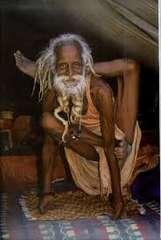HK, AGTSP, PAMHO,
Dear Gurudeva,
Same old, same old, as they say. Nothing particularly exciting to add, except that existence feels more like waiting to complete a jail sentence in this realm than anything else. Evil always seems to pervade over good in every corner of this world.
One may wonder: Is what we were promised in the sastras truly delivered, fully developed, or attained (for the lack of a better term), or is it all a fantastic hoax? Humbly, I reiterate the question from my previous report that remained unanswered:
HpS - AgtSP. Previous report?? Did not see it! 😲
So, nice to hear from you.
https://vedabase.io/en/library/lob/28/
"The devotees of the Lord, therefore, make the best use of the bad bargain by utilizing the temporary creation in the service of the Lord."
We are in a prison. There is chance for psycho-therapy, occupational training, family counseling. We want to get out, but right now this is the best place for us. We become ready for the spiritual world. Not dumped back into prison again after three months out because of our violent nature and inability to make money nicely.
We can even become psychologists and guards!
I would like to ask about CC Madhya 22.158, regarding siddha-rūpeṇa. I've read a brilliant article by Vraja Kishor Prabhu on Madhurya Kadambini titled Why Our Japa Still Stinks, where he suggests a logical progression to improve Japa by using the eight steps of Patanjali's Yoga Sutra as a template. The immediate goal would be to finally reach some substantial improvement in concentration, thus leading to nishta-bhajan (Dhyana and Samadhi). The author emphasizes that after Pratyahara, or trying to leave behind the "false" identity to stop distracting thoughts successfully, it is crucial to fill that gap with a "real" identity fit and ready to serve Krsna in a particular way, embracing this role internally, Dharana. Even if, at the beginning, it is a faceless character, chanting from such a role is what allows more depth while chanting.
Of course, this seems to be a very personal practice, but this devotee insists that if we think we are not qualified for it, we shoot ourselves in the foot. What is your advice on this matter? What do you suggest as reading/practice to start working towards that step? Is any specific approach facilitated by the spiritual master, or does it all fall into a homogeneous, holistic, general instruction?
ei nivedana dhara, sakhira anugata koro, seva-adhikara diye koro nija dasi
Thank you very much for giving me shelter, Dear Gurudeva.
Respectfully and affectionately,
Your servant,
Etasa Krsna Das
HpS - Preparing for Friday night class. Stomach ache. 90-degrees Fahrenheit. 🙂
Same as you, no?
We think about above a lot.
We remember Srila Prabhupada says, that for every stage in the Astanga yoga system, there is a corresponding stage in the Bhakti yoga system.
In our practice it seems so.
Above description of stages in contrast seems fine. We see little different but not means we are better.
Don't remember exact list from SP of the comparisons.
Eg. we take Pratyahara as the change when we stop letting the drum play us and we play the drum.
In the beginning it is very gratifying to the senses to beat the drum in regular strong strikes. It is sense gratification.
Because it is dovetailed with Hari kirtan it is like Nama-bhasa. It liberates us. We like the freedom.
Yet, we are not withdrawing from the external sensual experience and hearing the meaning of the Mantra or trying to use the percussion to ornament, illuminate, the Mantra. When that happens, even though it may not be ecstatic for the senses, we feel ecstasy, satisfaction in illuminating the meaning, punctuation, for the Mantra.
We take it to a deeper level.
Of course, the senses begin to like this position more than their blind, juvenile, gratification with no depth.
O.K.?
Is one idea.
Chanting and Dancing obviously handle aZana and prAnayAma, no?
Four principles, Tri-sandhyas ~= Yama, Niyama.
When you come to Goswami ... ? .... nistha/ruci... you start Raganuga Bhakti. Goswami, male, female, eunich, must be very intuitive: Gita = jitAtmana prasAntasya paramAtma samAhita, Intro to NoI = Once one becomes goswami everything else about how to advance will be automatically revealed.
So, our use of Srila P's books becomes more intuitive, not so regulated and linear, German, when we reach goswami - Pratyahara/dharana/dhyana.
Also, not like quantum jumps - You are Nistha! or you are Ruci!
More like a Bell Curve.
I might be little bit of neophyte, mostly Nistha, beginning Ruci and sometimes Prema (once every five years).
O.K.?
If we want to discuss more we should organize a colloquia, no? 🙂
References: To Dance in the Downpour of Devotion: A Summary Study of Madhurya Kadambini by Vraja Kishor.
Picture: The Book of Hours at the University of Chicago

